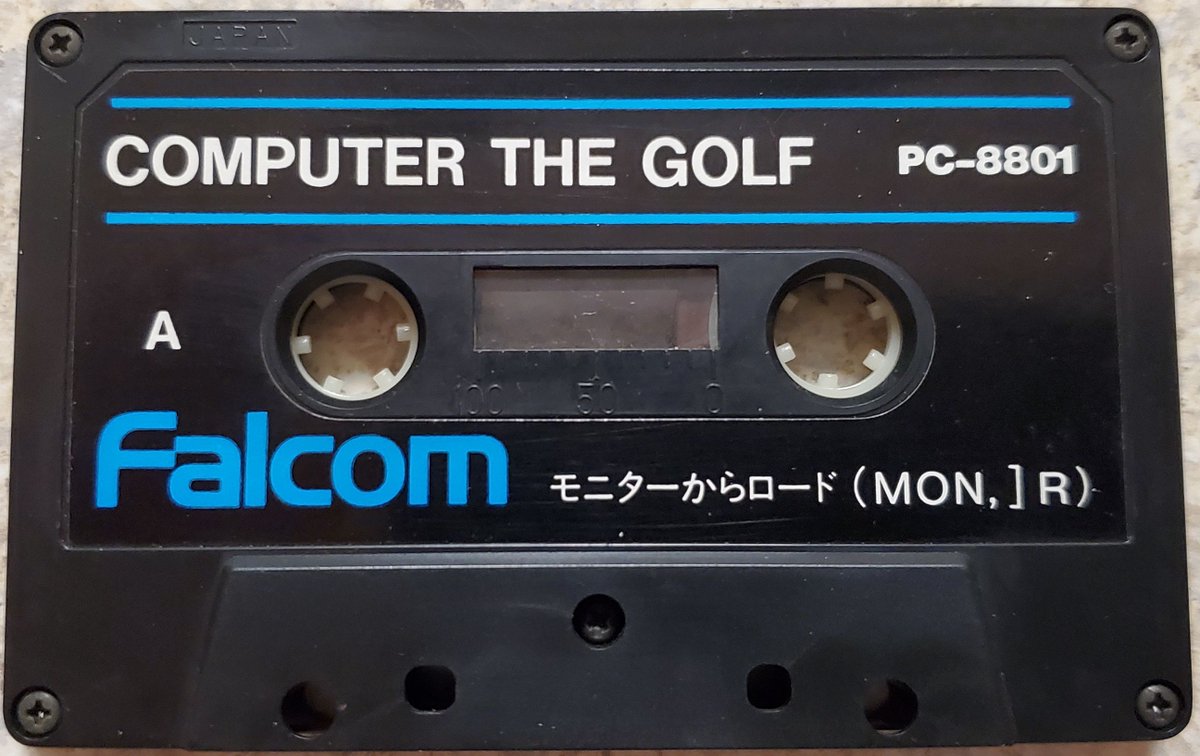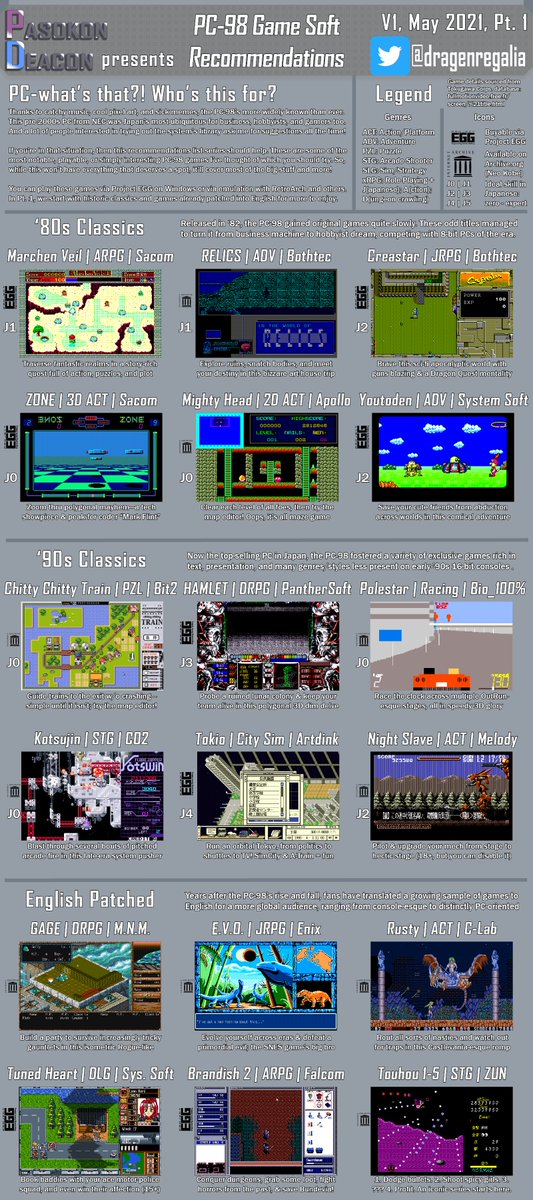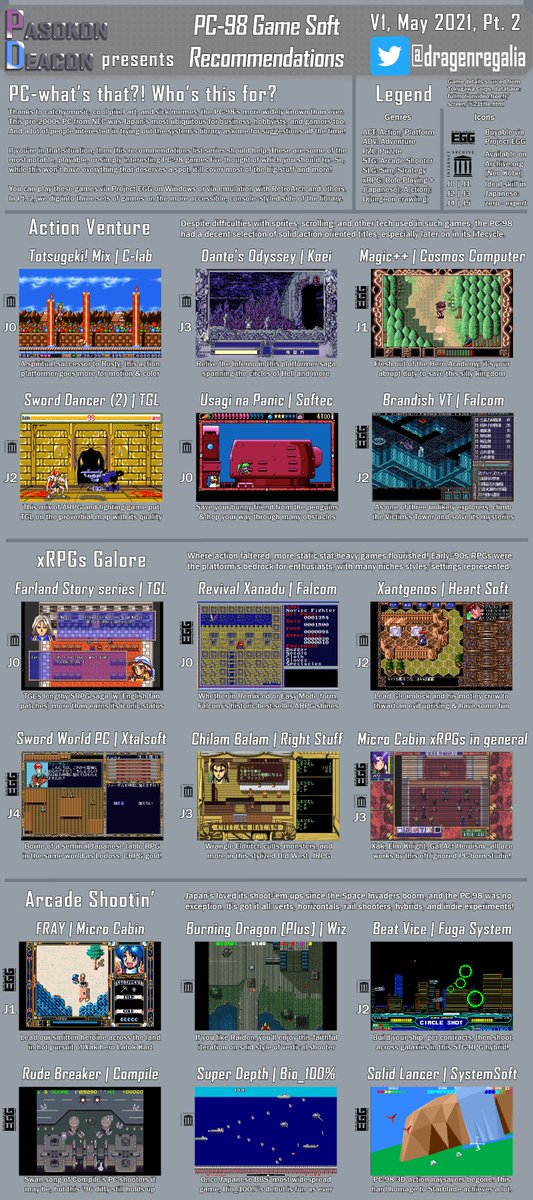This #PasokonSunday, it's a PC-88 golf game couple: Computer the Golf & Golf Island!
With the former's English fan patch from @GeofrontTeam, it's never been easier to experience Falcom's pre-Ys/-RPG period, let alone Tecno Soft's early PC games. It's digital golf for the masses!
With the former's English fan patch from @GeofrontTeam, it's never been easier to experience Falcom's pre-Ys/-RPG period, let alone Tecno Soft's early PC games. It's digital golf for the masses!
I know, neither look as exciting as Shin Sex 2: The Sequel to the Motion Picture, but look at it this way:
Falcom & Tecno Soft got folks skipping the golf club a year before Nintendo. Why spend possibly *millions* of yen on a club membership when a PC & game went for way less?

Falcom & Tecno Soft got folks skipping the golf club a year before Nintendo. Why spend possibly *millions* of yen on a club membership when a PC & game went for way less?


If anything, Nintendo's Golf from 1984 owes part of its design to earlier J-PC golf titles like these. Satoru Iwata was still making PC games up through '83, after all, & he's the coder behind so many early Famicom releases.
Both games would have been very appealing until then.

Both games would have been very appealing until then.


Computer the Golf, a tape game packed in an unassuming box, offers 9 holes & all your typical clubs, hazards, & random wind/slope patterns. It's also got a cute caddy & avatar animated throughout, limited as it looks.
For being one programmer's hobby project, it's quite a play!
For being one programmer's hobby project, it's quite a play!

Compared to Falcom's pre-Dragon Slayer slate, this little golf reel plays much better than usual. I'd rather try another round of this than, say, Private Stripper or their few early wargames
Golf Island's in a similar spot, with Tecno Soft hitting their stride about a year later
Golf Island's in a similar spot, with Tecno Soft hitting their stride about a year later

Like Falcom, Tecno Soft started out as a computer & electronics shop, the former in Tokyo & the latter in Sasebo way down south. These smaller sports games from one-time developers were normal for the time, a trend you'd see with Hudson & ASCII tape/disk releases from back then. 



Norihiko Yaku coded Computer the Golf and seems to lack any staff credits in future Falcom titles. Golf Island's creator, "T. Terao", has just as little notability. Meanwhile, wunderkinds like Yoshio Kiya & Kotori Yoshimura would soon come to define both studios' early output. 



Nonetheless, these unknown creators' golf romps lasted on the market longer than most similarly simple pre-'84 games. But how?
The simple answer: golf in Japan was expensive. Very expensive (and mostly still is).
Beyond costly daily plays, club memberships skyrocketed in price.
The simple answer: golf in Japan was expensive. Very expensive (and mostly still is).
Beyond costly daily plays, club memberships skyrocketed in price.

The nascent real estate bubble economy boosted conspicuous hobbies & consumption, and there was little more prestigious to own than access to exclusive greens.
It wouldn't be long before club memberships were valued high enough to need bank loans, or trade as commodities.
It wouldn't be long before club memberships were valued high enough to need bank loans, or trade as commodities.

So, in an era of rapidly unaffordable amateur golfing, digital golf became a lot more relevant.
Early golf game experiments on TV Pong consoles, Atari boxes, & kit PCs like NEC's TK-80/Sharp's MZ-80 paved the way for Computer the Golf, Golf Island, & other BASIC-coded examples!



Early golf game experiments on TV Pong consoles, Atari boxes, & kit PCs like NEC's TK-80/Sharp's MZ-80 paved the way for Computer the Golf, Golf Island, & other BASIC-coded examples!




Golf Island, for example, is already a nice improvement over Falcom's competitor in some key ways.
You can swap clubs before you swing, as well as compare average shot distances per club. The game randomizes hazard placement across runs, & your power bar moves slow & precise.

You can swap clubs before you swing, as well as compare average shot distances per club. The game randomizes hazard placement across runs, & your power bar moves slow & precise.


Both titles handle putting in a less than stellar way, using the wind indicator to show slope. Precise putts are difficult w/o an angle ruler, too.
NES Golf later indicated slope with chevrons on the map, let alone its two-step power bar which simulated swinging more accurately.
NES Golf later indicated slope with chevrons on the map, let alone its two-step power bar which simulated swinging more accurately.

While Computer the Golf came with a bit more personality thanks to the cartoony animations, Golf Island is a more complex, more austere game.
Meanwhile, T&E Soft was experimenting with golfer-view simulation that same year, predating their famous 3D golf titles from the '90s.



Meanwhile, T&E Soft was experimenting with golfer-view simulation that same year, predating their famous 3D golf titles from the '90s.




Golf Island was the only one of the bunch to get an expansion, adding 4 whole new courses. The main game & expansion got a well-valued rerelease as Golf Island Special in '84, by which point Tecno Soft's blazing hot Thunder Force & Plazma Line were dominating the line-up. 



• • •
Missing some Tweet in this thread? You can try to
force a refresh











